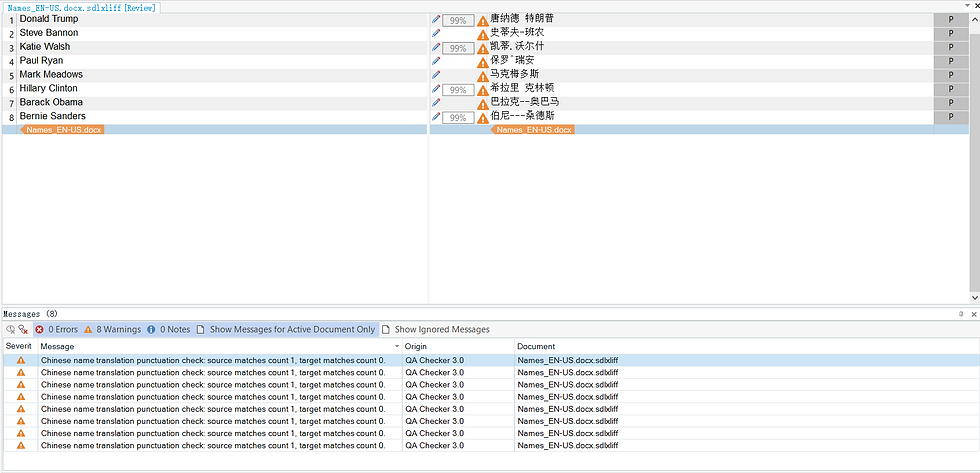Regular Expression for Trados
- Melanie Yang

- Dec 19, 2021
- 2 min read
Updated: May 24, 2022
Trados supports Regular Expression for the project QA function and Find & Replace function. Using regular expressions benefits the project manager and translators by giving them more possibility and flexibility of mistake auto-checking and fixing.
I. How can I access the Regular Expression function?
1 - Access Regular Expression window
Right-click the file that you will want to make the QA checks or quick Find & Replace fix in. Then choose “Open for Review”.

2 - Regular Expression Setting in QA Overview
Select the “Review” tab on the top, then follow instructions in the screenshot below.

3 - Regular Expression Setting in Find & Replace
Please make sure that Find options → Use → ‘Regular expressions’ is chosen before you do any code copy and paste.

II. Regular Expression Application
1. Check for “先生”
“Mr.” needs to be translated into “先生” in formal translation documents. The following code is for “Mr.” ---“先生” checking.
Description | "Mr." must be translated to “先生” for a formal project |
|---|---|
RegEx Source | (?m)Mr. |
RegEx Target | (?m)\u5148\u751f |
Condition | Source Match while Target not Match |
2. Check for “女士”
“Mrs.” or “Ms.” needs to be translated into “女士” or “太太” in formal translation documents. The following code is for “Mrs.” or “Ms.” --- “女士” or “太太” checking.
Description | "Mrs." or "Ms." must be translated to “女士” or “太太” for formal project |
|---|---|
RegEx Source | (?m)Ms.|Mrs. |
RegEx Target | (?m)\u5973\u58eb|\u592a\u592a |
Condition | Source Match while Target not Match |
3. Check Punctuation
Punctuation is something that tends to be overlooked during translation, especially when we are working with CCJK languages. When used in the wrong way, it might cause confusion and show how unprofessional the translators are. Here are several regular expressions that may help translators check for potential errors in punctuation use.
3.a. Check “.” and “。”
The Chinese period looks like this “。”, very different from its counterparts in European languages. Here is how you can use a regular expression to ensure that there is a Chinese period in the target text where there is an English one.
Description | The “.” in EN at the end of a sentence should be “。” in CN |
RegEx Source | \. |
RegEx Target | \。 |
Condition | Source Match while Target not Match |

3.b. No space in Chinese paragraphs
No space is needed when we are translating into written Chinese, but translators might accidentally type in space and it’s really hard to notice. This regular expression helps ensure that there is no space in the Chinese text.
Description | There should be no space in Chinese paragraphs |
RegEx Source | . |
RegEx Target | \s |
Condition | Both Source and Target match |

3.c. “·” between the first name and last name
When translating people’s names into Chinese, especially names that are in the European language, “·” should be put between the first name and last name (and middle name if there is one). The lack of “·” or the use of other punctuations such as “-” is considered incorrect. This regular expression helps ensure the name translation in Chinese uses the correct format.
Description | When translating names from European languages into Chinese, there should be “·” between the first name and last name |
RegEx Source | [A-Z][a-z0+\s[A-Z][a-z]+ |
RegEx Target | .+\·.+ |
Condition | Source Match while Target not Match |





Comments